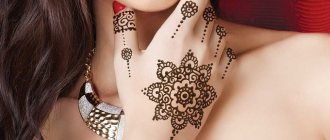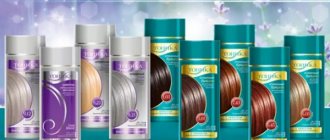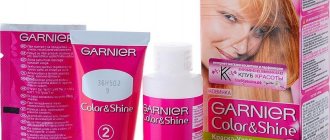What is Basma?
Basma is a powder of indigofera (a tropical shrub), which is obtained from its leaves, and has a greyish-marsh color. The dye is used to produce blue and black colors, but along with the coloring properties, this product has a healing effect. This method of dyeing was first carried out in the East.
Advantages and disadvantages
This natural dye has positive properties, due to which it is preferred to other chemical elements. The first thing that can be noted is the presence of vitamin C in the dye. This brings undoubted benefits to the hair, nourishing it, moisturizing and strengthening it. This vitamin is beneficial even for gray hair. Basma also nourishes the scalp, thereby stimulating the growth of new curls and making them healthier.
In ancient times, this natural component was used as a beneficial substance for the liver by ingesting it. Thus, the condition of the hair improves from the inside: dandruff, excessive oiliness of the hair and other problems are subsequently eliminated. Reviews from many women indicate that after using this dye, the strands stopped falling out and the hair became thicker. This product can also be used even if you are allergic to chemical dyes, without fear for your scalp.
It is fair to note that the dye also has disadvantages. Firstly, hair dyeing with basma should be done with caution and strictly following the instructions. It can give your hair an unwanted greenish or bluish tint. Secondly, if you overdo it with the composition or frequency of dyeing, you may dry out the strands.
It is not recommended to use basma in its pure form!
Basma - good or bad for hair?
Basma powder contains a lot of useful minerals that help strengthen and restore the hair structure. Due to the presence of a rich complex of natural ingredients, basma for hair is very useful:
- tannins help eliminate foci of inflammation, prevent the spread of irritation and help quickly heal wounds and cuts;
- natural resins and wax nourish the hair follicles, due to which curls grow much faster and hair loss is reduced;
- mineral components restore the scalp, fight harmful bacteria and eliminate dandruff;
- vitamin complexes and plant extracts strengthen the strands, making them elastic and bouncy.
In addition, dyeing your hair with basma will significantly increase the volume of your hair, which is indispensable for owners of thin and sparse strands. An additional advantage of this herbal component is its natural origin, which prevents the development of allergic reactions, so it can be used by allergy sufferers and people with hypersensitive skin.
Useful tips when using basma for hair coloring
Using vegetable dyes for the first time, you may encounter unforeseen difficulties, since careless use of the coloring component or incorrect selection of proportions will lead to uneven or incorrect coloring.
- A few drops of ammonia will help enhance the effect of the dye, but in this case the time of exposure of the product to the hair should be halved;
- During the painting process, protective capes should be used on the shoulders and floor to prevent paint drops from splashing. If you accidentally stain your hands or neck, rub the stained area with a slice of lemon or immediately wash with detergent;
- Thoroughly washing your hair with lemon water or washing your hair twice with soap will help wash off an overly bright shade;
- Combining basma and henna with other natural dyes will help to diversify the shades; you can use beet juice, coffee, tea;
- hair after basma may become somewhat harsh; to make it soft, you should use your usual balms and rinses, but they can only be used 2 days after dyeing.
When choosing between store-bought paints and natural products, it is, of course, better to give preference to natural products, but they should be used according to the instructions and not overuse coloring. Remember that any impact on the hair leads to a change in its structure and over time can cause irreparable damage to the hairstyle.
How to paint?
Many people are interested in the question of how to dye their hair with basma. This dye in its pure form will give a green or blue tint to the strands, this will be especially noticeable if you have light hair. Weakened and damaged curls are intensively dyed, and the result may not please you.
Henna and basma do not interact with chemical elements, so dyeing should be done on undyed hair that has not previously been subject to other chemical treatment.
Basma on curls lasts for more than six months, but by the end of the period a reddish or purple tint may appear, so the color needs to be refreshed periodically, but this should not be done more than once a month - such a dye dries out the hair and scalp, and frequent dyeing can lead to negative consequences. consequences.
If you decide to give up painting with basma and switch to synthetic coloring, then the vegetable dye must be completely washed off, otherwise an unpredictable coloring result is possible due to the plant component reacting with the chemical one.
Having naturally dry and thin hair, it is advisable to add olive, castor or almond oil to the dye. Don't overdo it - the paint may not adhere well. This coloring mixture will add shine and additional moisture to dry curls.
How to dye your hair with henna and basma?
The proportions of these components for various shades:
- to get a chestnut or chocolate color, use one to one proportions (equal proportions of powders of the two components);
- the desired black color can be obtained by taking elements at the rate of 1 part of henna to two parts of basma;
- to get a bronze shade, take two parts of henna and one part of basma.
To protect yourself from unpredictable coloring results, try applying the color mixture to a separate strand of hair. If you are satisfied with the result, then feel free to apply it to the entire length. This combined dyeing takes place in two stages - first henna is applied, then basma, so dyeing at home will be more durable and the colors will be richer.
How to dilute the dye?
When preparing the coloring mixture, several rules should be followed. The dye powder is poured with hot water at a temperature of at least 90 degrees. The quantity is calculated depending on the length of the hair. Thus, for short curls you will need about 100 grams of powder, for medium length (from ten cm) - 200 grams, for long curls (below the shoulder blades) - 300 grams, and if the strands are waist-length, you will need 500 grams.
The mixture should be applied to the strands while it is still hot.
When mixing the dye with henna or other components, the technology for preparing the mixture is no different; you just need to add the required amount to the powder. It is also worth noting that at too high temperatures, henna is baked, for this reason the water needs to be cooled a little (70-80 degrees).
Basma for gray hair
To dye your hair at home and get rid of gray hair, you need to stretch out the process over several days. You won’t be able to get a beautiful shade right away if you have a large number of gray strands - perhaps not all your hair will be dyed. For dry and damaged curls, add oil to the dye mixture at each stage so as not to dry out your hair.
Adding natural ingredients such as tea, Cahors and coffee allows you to get more noble colors and cover gray hair more thoroughly. For women whose hair color is ashy or blonde, these hair dyes are not suitable. The color will turn out tangerine, and washing it off will be problematic.
To get a black color, you need to take equal proportions of the components; this recipe is especially suitable for painting gray hair on brunettes. If you did not get the desired black color and did not remove the gray hair, then the next day you need to carefully paint the problem areas again, it is better that the components are in the same proportions.
Other shades
If you want to get an unusual color, use the following recipes when painting:
- For a light chocolate color, add weak tea leaves or coffee to the paint mixture.
- To cover gray hair and get beautiful ruby shades, henna is used along with basma and heated Cahors.
- Adding chamomile infusion gives rich golden colors.
Henna, when mixed with basma, does not give black color to light hair; for these purposes it is better to use synthetic dyes.
Coloring with these components will not necessarily give only a black tint; by adding various components, you can get interesting colors and perfectly cover gray hair.
Dyeing process
Dyeing strands with natural dyes should only be done with a freshly prepared mixture; during long-term storage, the components will oxidize, and the result will not be what you planned. To protect your neck from staining, wear a bandage or wrap it in cellophane. Apply a rich cream along the hair growth - this will help you easily wash off the dye in case of accidental contact.
The composition is applied according to the same rules as synthetic dye - careful dyeing strand by strand. The coloring components have a fluid composition and can easily drain from the hair, so you can add oil or glycerin to the mixture for better retention.
The lighter the shade you want, the less time you will need to dye. This usually takes from 1.5 to 6 hours. It all depends on the structure and susceptibility of the curls to dyeing, so it’s better to try on one strand to calculate the exposure time.
How to wash off the paint after the procedure?
This mixture is quite problematic to wash off, this is worth taking into account. You need to rinse your hair extremely thoroughly, otherwise, after drying, powder will remain throughout all the curls.
The mixture is washed off with running water without using shampoo. If the basma is stale, then a few drops of ammonia will help revive it.
At the end of the wash, you can use conditioner. It is recommended to use regular shampoo only after a few days.
Application
There are 2 ways to dye hair with basma - separate and simultaneous. Both methods involve mixing it with henna.
Rules for using basma:
- The composition must be diluted immediately before painting.
- The areas of the skin along the hairline must first be treated with a rich cream. This will make it easier to wash off the dye.
- You must wear complete gloves on your hands. It is not recommended to work with paint without them.
- It is advisable to throw a protective cloth of appropriate purpose over your shoulders, which is used in beauty salons, or a piece of any material. A towel, sheet, or old T-shirt will do.
- After dyeing, it is recommended to put a plastic cap on your head.
- Basma and henna are mixed in proportions that allow you to obtain the desired shade (more on this below). The resulting composition is poured with hot water, but not boiling water. The maximum amount of liquid is 800 ml.
The required consistency is determined individually. The best option is the thickness of sour cream. The coloring composition is evenly distributed over the surface of the hair with a cosmetic brush.
You need to wash your hair with warm water and shampoo. It is not advisable to use a hair dryer immediately after dyeing. It's better to let your hair dry naturally.
The separate method of dyeing curls involves sequential treatment with basma and henna. First, a composition of indigofera leaves is applied. Leave for 30-40 minutes, then wash the hair and dry it.
Only after this henna is applied to obtain the desired shade. The owner of long hair will have to spend at least 2 hours to complete the process. The simultaneous method involves the joint use of natural dyes.
Proportions are calculated individually depending on the desired hair color. This method has an obvious advantage, which is the speed of the process. The number of operations is much less compared to the separate technique.
A significant disadvantage is that it is easy to make a mistake with the proportions. Experience and good knowledge of the peculiarities of your own appearance are required. The entire simultaneous staining procedure takes a maximum of 50 minutes.
Henna and basma combined in equal quantities on fair-haired girls give an attractive chestnut tint. On the owner of blond hair, this proportion will look like an exquisite shade of milk chocolate.
Basma for hair (reviews especially note the variety of color solutions and the dependence on the natural color type), combined with henna in a ratio of 1:3, gives a delicate and gentle light brown tint.
But this only applies to girls with naturally light hair. Those with other colors of appearance will not be able to get this shade. The desired color nuance is determined experimentally.
When you mix basma with henna in a 1:2 ratio, your hair will turn a catchy fiery red hue. On blondes it will look like a real fox color, and for girls with naturally dark curls this composition will give an exquisite and noble bronze tint if you leave the dye on your head for 30 minutes. instead of the required 15.
For those who want to give their strands a rich and catchy shade of dark chocolate, it is recommended to combine basma with henna in a 1:3 ratio. Exposure time – 15-20 minutes. To obtain a radical black color, the coloring composition must remain on the head for at least 1.5 hours.
When preparing the mixture, it is important not to mix henna and basma in the same container. Otherwise, you won't be able to dye your hair properly. This is due to different susceptibility to high temperatures. In hot water, henna instantly curls up and loses its coloring properties.
Basma, on the contrary, acquires them in liquid at a temperature of at least +70°C. Therefore, you need to mix the compositions that have already been diluted to a creamy state.
Radical black color is obtained by separate processing as follows:
- First, henna is applied.
- Leave it on your head for about 1 hour, then wash it off.
- Next, the strands are treated with basma.
- The longer you leave it on, the blacker your hair will become.
- If the time the basma remains on the hair exceeds 4 hours, a slight bluish tint will appear.
This technique is universal and suitable for the owner of any natural color type. There are many homemade recipes for preparing coloring compositions from henna and basma. They allow you to obtain extraordinary shades.
Blonde girls are recommended to use mixtures with a predominance of henna. The optimal option for owners of dark brown hair and brown-haired women is an equal proportion with a slight individual correction depending on the natural color type.
For burning brunettes, it is advisable to focus on the predominance of basma to create a lightening effect.
The following special ingredients can be added to such coloring mixtures, which will help create a completely extraordinary aesthetic solution:
| Component | Intended cosmetic effect |
| A few drops of red table wine or cranberry juice | Light ruby tint |
| 1 tsp ground coffee | On blondes there is a shade of milk chocolate. For those with other colors of appearance – the rich color of dark chocolate. |
| Beet juice | Noble burgundy color |
| Chamomile | Warm honey-golden tint. Turmeric has a similar effect. |
| Saffron | Original amber shimmers |
| Ground cloves | Enhances black color and deepens chestnut shade with a natural sheen of tree bark. |
| Cocoa | Gives light brown hair an interesting play of light and shadow. |
| A pinch of table salt | Helps coloring pigments to fully reveal their aesthetic possibilities. Sea salt additionally strengthens hair follicles. |
| Burdock oil | Useful for dry and weakened shafts. Gives curls greater density and elasticity. As a result, the curls will look voluminous and luxurious. |
| Kefir | Moisturizes the skin and gives hair a “silicone” shine. |
Adding a few drops of ammonia to the coloring mixture reduces the exposure time on the head.








